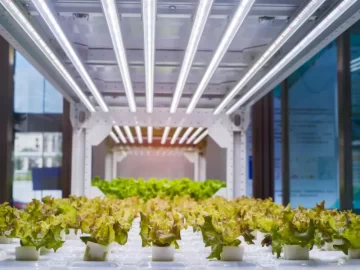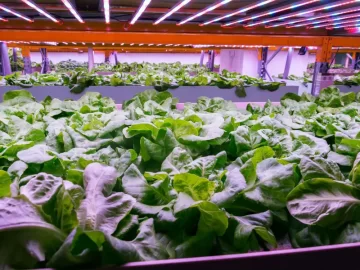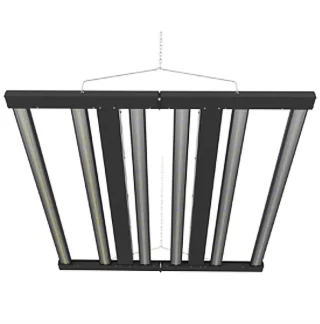Indoor LED Lighting Products
Led Grow Lights: Illuminating Your Indoor Garden
CALL US NOW FOR YOUR LED LIGHTING SOLUTIONS ...
CLICK TO CALL 1-800-8385070Welcome to the wonderful world of indoor gardening! Proper lighting is essential for achieving optimal plant growth and development, whether you’re a novice or an experienced gardener. They are a game-changer for indoor gardening – discover their excellent benefits and transform your space today!
Why LED Grow Lights?
Indoor gardeners often choose LED grow lights for a good reason. They are a modern led lighting solution that provides many benefits over traditional lighting methods like fluorescent and incandescent bulbs. Here are some advantages of using advanced LED lighting systems for growing plants:
Energy Efficiency
Using these lights instead of traditional ones can significantly reduce power consumption, resulting in lower electricity bills and a smaller environmental footprint.
Long Lifespan
Were you aware that LEDs have a lifespan of more than 50,000 hours? This implies that you won't have to replace the bulbs as often, a fact that can save you a substantial amount of time and money in the long haul.
Customizable Spectrums
You can customize the spectrum according to your plants' needs with LED grow lights. You can optimize plant growth and maximize yields by providing the ideal photosynthesis wavelengths.
Get Your Free Quote here!
Low Heat Emission
They produce less heat than traditional bulbs, reducing the risk of heat damage to your plants. It also means placing the lights closer to your plants without worrying about scorching or wilting.
Compact and Lightweight
Grow lights that use LED technology are easy to move around due to their lightweight and compact design. It makes them an excellent choice for indoor gardeners who have limited space.
Understanding Light Spectrum for Plant Growth
It is important to comprehend the varying light spectrums and their impact on plant growth to maximize the benefits of LED grow lights. When dealing with plants, it is important to consider the effects of different light wavelengths. The following are some essential factors to bear in mind:


Blue Light (400-500 nm)
Blue light stimulates the production of chlorophyll, which is essential for plant growth. It promotes strong stem and leaf development, ideal for seedlings and young plants.


Red Light (600-700 nm)
Red light is essential for flowering and fruiting stages. It triggers the production of hormones responsible for flowering, ensuring robust blooms and bountiful harvests.


Full Spectrum
Some LED grow lights offer a full spectrum that includes a range of wavelengths from blue to red, mimicking natural sunlight. This comprehensive spectrum is beneficial for plants throughout all stages of growth.
By tailoring the light spectrum to the specific requirements of your plants, you can optimize their growth, flowering, and overall health.
Choosing the Right LED Grow Lights for Your Plants
Pick the right one if you’re considering adding LED grow lights to your setup. To ensure you make the best decision, here are a few factors to ponder:
- Plant Type: Different plants have varying light requirements. Leafy greens, like lettuce and herbs, thrive under blue-dominant spectrums, while flowering plants, such as roses and tomatoes, require a combination of red and blue light.
- Growth Stage: The growth stage of your plants determines the ideal light spectrum. Seedlings and young plants benefit from higher blue light intensity while flowering and fruiting plants need a higher ratio of red light.
- Coverage Area: Evaluate the size of your indoor garden and choose LED grow lights that can adequately cover the entire area. Consider adjustable or modular systems if you have plans to expand your garden in the future.
- Brand Reputation: Choose well-known brands recognized for their excellent quality and dependability.
Investing in high-quality LED grow lights is essential to maximize your plants’ growth and yield.
Conclusions
Lighting solutions powered by LEDs have revolutionized indoor gardening. Keep your indoor garden healthy year-round by picking the right LED grow lights, knowing everything about the light spectrum, and ensuring your lighting situation is right. With LED grow lights, you get an energy-efficient, long-lasting, customizable option. The power of LED grow lights will ensure your plants thrive like never before!
Talk to our Light Expert Today!
CLICK TO CALL 1-800-8385070Frequently Asked Questions
LED grow lights can provide an excellent alternative to natural sunlight for indoor gardening, but they can only partially replace it. Natural sunlight offers a broader light spectrum and natural variations that are difficult to replicate entirely with artificial lighting. However, LED grow lights can supplement or enhance natural light, ensuring your plants receive adequate illumination even in low-light environments.
The distance between LED grow lights and plants depends on their wattage and the light intensity your plants require. As a general guideline, start with a 12-18 inches length and monitor your plants’ response. You can move the lights closer if they appear stretching toward the light source. On the other hand, if you notice signs of light burn or bleaching, increase the distance between the lights and plants.
LED grow lights produce less heat than traditional lighting options. However, they do emit some heat, especially at higher wattages. It’s essential to ensure proper ventilation and airflow in your indoor garden to prevent heat buildup. Additionally, check the manufacturer’s guidelines for temperature recommendations and make any necessary adjustments to maintain an optimal growing environment.
The light your plants require depends on their growth cycle and individual requirements. A vegetative plant needs 12-16 hours of light a day, whereas a flowering plant needs 8-12 hours. However, some plants may have unique light requirements, so research them first.
LED grow lights suit various plants, including vegetables, herbs, flowers, and exotic plants. Selecting LED grow lights with the appropriate spectrum for your plants is crucial. Some plants require specific lighting, such as high-intensity lighting for fruiting plants or UV light for flowers.
LED grow lights are more energy-efficient than traditional lighting options. They consume significantly less power while providing the same or better light intensity for plant growth. Saving energy can lower your electricity expenses and minimize your carbon footprint.

